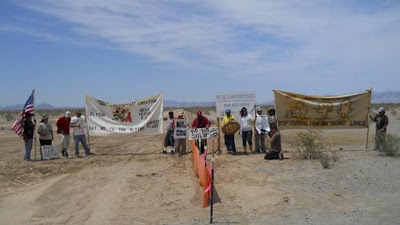Stateline Solar Begins Environmental Review Process

The Bureau of Land Management (BLM) has begun reviewing the proposed Stateline Solar power project, which is expected to destroy at least 3.4 square-miles of the Ivanpah Valley. First Solar Inc. has been considering whether or not to move forward with this controversial project since the nearby Brightsource Energy solar project (ISEGS) has made headlines for its unprecedented impacts on the threatened Desert Tortoise.
This map, obtained by Basin and Range Watch , shows the projected footprint of the photovoltaic panels that will carpet excellent desert habitat with steel and glass. The desert habitat to the west of the Stateline project is already being bulldozed for the Ivanpah Solar Electric Generating System (ISEGS) by Brightsource Energy.
Probably seeking to shield the company from expected opposition, First Solar is reportedly looking to strike a deal with NatureServe, a non-profit with Wall Street ties, to draw up a conservation plan for the the Ivanpah V...


